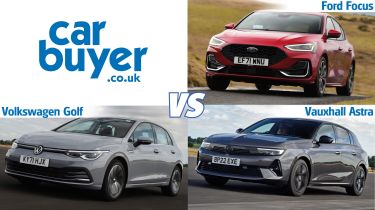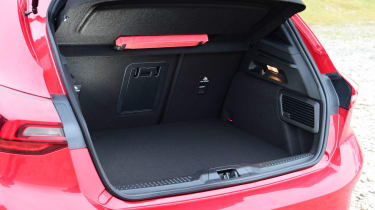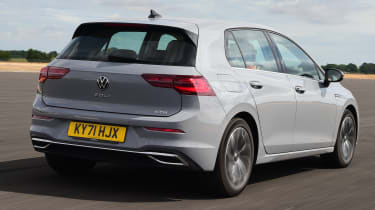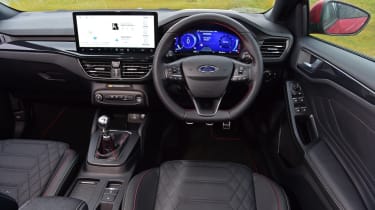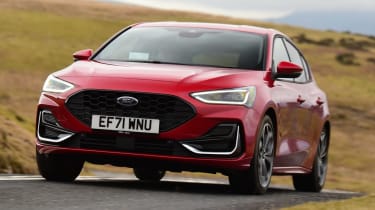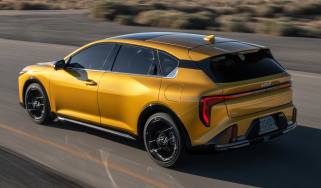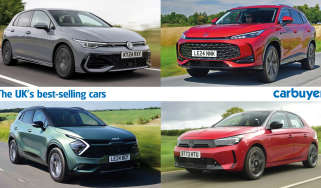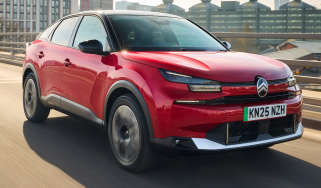New Ford Focus vs VW Golf vs Vauxhall Astra: rivals comparison
The Ford Focus has had a recent refresh, but how does it compare to the latest Volkswagen Golf and Vauxhall Astra?
Nowadays we expect a family hatchback to do more than just get the kids to and from school. It should include the practicality of a large, easy-to-load boot and have an economical engine that keeps running costs down. Buyers also want a car that looks good, is fun to drive and affordable to buy in the first place.
The original Ford Focus did just that in 1998, rejuvenating a flagging Ford brand by offering something everyone in the family could enjoy – it ticked all the usual boxes and its ‘New Edge’ styling and great handling at a reasonable price meant the Focus stayed at, or near, the top of the sales charts over the course of three generations. However, can the latest Ford Focus hold its own against the Volkswagen Golf and Vauxhall Astra, which now make for some fierce competition in the hotly contested family car class
 The top 10 best family cars 2025
The top 10 best family cars 2025
The latest Volkswagen Golf has been on sale since 2020, with the most recent Vauxhall Astra arriving at the end of 2021. The Ford Focus also recently underwent a refresh to keep ahead of the game. Of course there are plenty of other rivals in this segment, such as the Skoda Octavia, SEAT Leon, Mazda3 and Kia Ceed, but how do the three main big-name rival models compare?
Read on for our specs comparison of the Ford Focus, Volkswagen Golf and Vauxhall Astra…
Which is the most practical?
One of the Mk3 Focus’ biggest issues was a lack of interior and boot space – but the new Mk4 Focus now isn’t far off competitors with a 375-litre boot. That’s still five litres behind the Golf’s 381-litre boot capacity and well behind the Vauxhall Astra’s large 422-litre boot, however. With the seats down, the Focus does offer 1,354 litres of space, which is actually more than the Astra’s 1,339 litres and the Golf’s 1,237 litres, so the Focus can offer up the space when needed.
Although it has a bigger boot with the seats up, the Vauxhall Astra doesn’t offer a lot of kneeroom for its rear occupants. The current-generation Ford Focus was redesigned mostly to allow for more space for passengers than it did before, and it shows. Both the Golf and Focus are more generous than the Astra in this respect. All three cars are fairly evenly matched when it comes to headroom.
The Focus just pips it here in terms of rear passenger space. The Golf’s transmission tunnel (the hump in the middle of the car that runs through the interior) is more intrusive than in the other two, meaning the back is more suited to just two passengers. The Astra’s transmission tunnel is smaller, but the Focus offers space for three rear passengers to sit fairly comfortably without looking for a place to put their feet.
The Focus has the best balance between the three for interior comfort, space and practicality.
Which car is the safest?
The Focus and Golf were both given five-star Euro NCAP ratings when they were tested, but the Astra lags behind here with four stars. It’s worth noting, though, that Euro NCAP makes its tests more stringent every two years. The Focus was tested before its refresh, and the current generation of Astra is essentially the newest of the three, facing the more rigorous testing criteria. In effect this means the differences are more marginal than they first appear.
The Astra did achieve just 66% for its included safety kit; such as lane-departure warning, autonomous emergency braking, speed sign recognition, hill-start assist and a forward collision system that works at low speeds. Higher trim levels offer improvements to these existing systems, such as traffic sign recognition and a forward collision system that also functions at higher speeds. There’s also lane-positioning and lane-change assist, blind-spot monitoring, intelligent speed adaptation, and a 360-degree parking camera on top spec models.
The Focus got a 75% Euro NCAP score for its wide array of safety kit, which includes the use of three radars, two cameras and 12 ultrasonic sensors – that’s more than any Ford that’s come before it, so it shows how serious the brand is about safety. ‘Evasive Steering Assist’ is the latest safety tool which allows the car to avoid colliding with slow moving or stationary vehicles, sitting alongside tech like a reverse camera, adaptive headlights that avoid dazzling other drivers and the optional ‘Co-Pilot 360’ pack including autonomous emergency braking, adaptive cruise control, traffic sign recognition and lane keep assist.
The Volkswagen Golf offers the most impressive roster of safety assistance technology which was rated 78% by Euro NCAP in testing – higher than the other two hatchbacks. Highlights of the Golf’s safety systems include lane keeping assist, Car2X communications that share hazard warnings between cars, LED Matrix headlights and driving aids that can help drive the car at speeds of up to 130mph.
Which has the best infotainment system and connectivity?
The Focus was treated to a complete technological overhaul compared with the last generation. Base models get a slim eight-inch touchscreen that sits above the dashboard and reacts to pinch and swipe gestures – this is bigger at 13.2 inches on all the other trim levels. It uses the latest version of Ford’s SYNC 4 software, and you can also connect your smartphone and display Apple CarPlay or Android Auto on the screen, just like in the Golf and Astra. SYNC 4 is a marked improvement over the previous SYNC 3 system used on the pre-facelift models, with snappier loading times and sharper graphics.
The latest Astra comes with two ten-inch screens – one for the gauge cluster and one for the infotainment in the middle of the dash. Larger 12-inch screens come on the higher trim levels, and will be standard across the range for the 2023 model year. The Astra’s voice controlled system was particularly intuitive to use.
The Golf’s system works well, looks attractive and is responsive to touch sensitive commands. All cars get a 10-inch infotainment screen and a digital instrument cluster and include plenty of technology previously reserved for luxury saloons. It’s let down, however, by climate controls which are operated by a touch sensitive slider which is easy to press unintentionally, and it’s not backlit which makes it hard to see at night. That said, its Car2X tech allows the Golf to talk to other cars and infrastructure to warn you about upcoming hazards and traffic, as well as showing you where vacant parking spaces are in real time.
The recent improvements to the Focus’ software now make it one of the class leaders in this respect, although the impressive features offered on the Golf might appeal to buyers who aren’t bothered by some of its ergonomic niggles.
Which has the cheapest running costs?
Impressive fuel efficiency figures of around 50mpg suggest a petrol Vauxhall Astra should save you money on fuel. It’s also available as a diesel which gets around 64mpg which is good news for high-mileage drivers, and there’s a plug-in hybrid version which can do around 40 miles on electricity alone and will have much cheaper Benefit-in-Kind (BiK) costs. However, the Astra is predicted to suffer from the worst loss of value over the years compared to the Focus and the Golf.
 Top 10 best plug-in hybrids on sale today
Top 10 best plug-in hybrids on sale today
Most Golf and Focus models are likely to be similar in terms of fuel-efficiency, achieving MPG figures in the high 40s. The Golf is also available as a plug-in hybrid like the Astra, which should also make it cheap to own as a company car thanks to lower BiK rates – it’s capable of 37 miles on electricity alone. The Focus falls behind in this area, as it’s still not available as a plug-in hybrid, but is the most likely of the three to hold onto its value.
Which is the best to drive?
Dating right back to the Mk1 Focus, Ford has long been praised for making even its more family-focused models fun to drive – that still applies to the current generation Ford Focus.
The Focus offers the perfect amount of feel through the power-assisted steering, and keeps its composure through twisty roads, which makes it a pleasure to drive. The manual gearbox offered on some of the 1.0-litre models feels slick to use, even if it’s a little weighty. The automatic gearbox is smooth for the most part, although it’s prone to the occasional jerky shift.
The Golf’s DSG automatic gearbox is much more responsive than the one used in the Focus, but when it comes down to handling, the Golf doesn’t quite keep up. Admittedly, the Golf’s handling will depend on the trim level you choose, as lower spec models have simpler rear suspension, but even with the optional adaptive dampers that can be configured through various driving modes, the Golf isn’t quite as fun as the Focus. The steering either feels too vague or the ride too stiff and unforgiving depending on the settings.
The Astra feels sportier than previous generations, and this means it’s more fun to drive than ever. It’s still not quite up there with the Ford Focus in terms of driving engagement, but it’s closer than it’s ever been before. A downside to its new-found sportiness is a harsher ride – it doesn’t iron out bumps in the road quite as well as the Golf. Its manual gearbox is okay, although the automatic gearbox is a much smoother alternative.
Verdict: Which should you buy?
The current generation of Focus, Golf and Astra are more closely matched than in previous years, and the choice between them largely depends on personal preference. The Focus will still appeal to those looking for a family car that can still please the driver, as much as it does the rest of the family through its practicality, comfort and much improved in-car tech. However, Focus pricing has crept up over the years, meaning it’s not necessarily as good value as it was before.
The Golf used to be the more premium choice, but the latest iteration shows evidence of cost-cutting, with cheap-looking plastics creeping into the interior, and gas struts replaced with a metal pole to prop up the bonnet when you open it. It’s also not the most engaging car in terms of driving feel.
The Astra is more fun than it’s ever been before, and should offer cheap fuel bills, especially with the option of a plug-in hybrid for those who do lots of small trips around town. It could lose value more quickly than the other two, though not as quickly as previous generations of the Astra did. For those reasons the Astra might be the better choice for many, given it ticks so many boxes in areas crucial to family car buyers.
Read our guides to the most economical family cars and the best used family cars.
Recommended
Most Popular
Tips & advice

Car dashboard warning lights: what does each symbol mean?

Electric car charging stations: public networks, charger types, apps and maps


